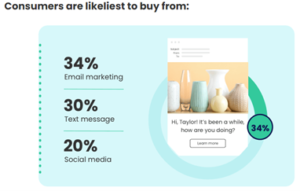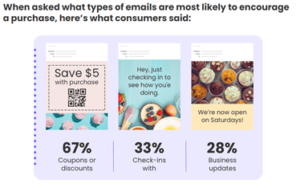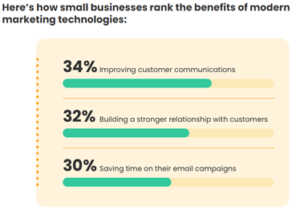This article has some great info. I’m going to give you the executive summary in case you’re short on time!
What Customers Want to See in 2022
When it became clear that the effects of COVID-19 would be sticking around for a while, Constant Contact began a large-scale research initiative aimed at helping small businesses understand how their customers are changing and how businesses should adjust to meet those expectations.
The data and the trends we’re seeing from our own customers show a disconnect between what small businesses think their customers want and what consumers are actually looking for.
Small businesses are relying heavily on social media to drive financial results, but consumers don’t shop there very often.

The best way for a small business to get the most out of its social media presence is to combine it with other marketing methods to create personalized experiences for customers, nurture them over time, and ultimately drive repeat business.
Email marketing still has the highest return on investment of all forms of marketing, with an average return of $36 for every $1 spent.
Small businesses are confident that they know their customers’ needs, but most are not communicating the information consumers want or using the channels they prefer.

Consumers say emails with a coupon are 83 percent more likely to be opened than an email newsletter, 67 percent more likely to be opened than an abandoned cart email, and 64 percent more likely to be opened than a well-being checkup email.
Infusing email marketing campaigns with ecommerce elements allows each of those tools to work together, which helps small businesses deliver more valuable content to subscribers while generating more revenue in the process.
Small businesses are starting to optimize their email marketing, but there’s more they could be doing to cut down on manual effort, improve personalization, and retain customers

Many small businesses send newsletters or welcome emails to new subscribers, but an even better way to engage those users is to take things a step further and create an automated welcome series.
Brick-and-Mortar stores are currently “in” for shoppers, but ecommerce is their new baseline
58 percent of SMBs we polled started selling online for the first time after COVID-19 hit. Evidently, this was a major differentiator for consumers because when asked if they shop at small businesses more today than before the pandemic, 41 percent said yes.
- 86 percent of consumers have bought something online in the last month, and 61 percent have ordered in the last week
- 35 percent said an issue with an SMB’s website, or an inability to buy online would discourage them from being a patron of that business
- 45 percent of small businesses still don’t have a website for their business and 43 percent of those with a physical store are not currently selling online.
Owning the entire purchasing process from awareness to fulfillment gives small businesses complete control over what a shopper experiences when engaging with their brand, and it allows them to tailor that experience in a way other online platforms don’t allow.